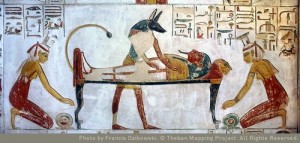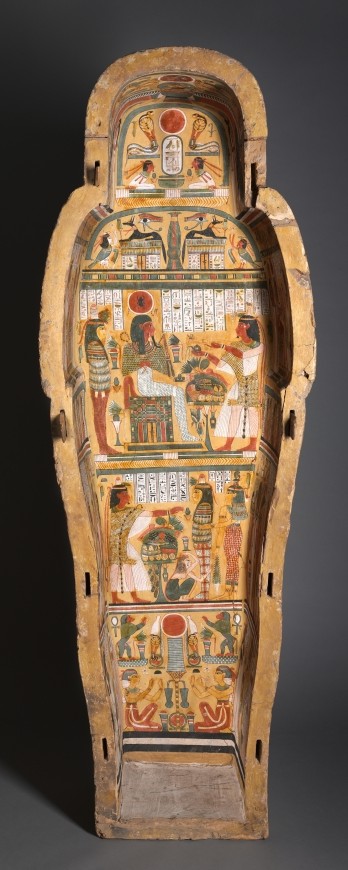
Isis and Nephtys with their hair covered by a white cloth and with a red band. Scene from the tomb of Siptah. XIX Dynasty. Photo: The Theban Mapping Project.
The iconography in Ancient Egypt was not gratuitous. Every image had a reason to be, but also every space.
From the Old Kingdom the two mourners in the role of Isis and Nephthys were accompanying the dead until the tomb at both ends of the mummy. The hieroglyphs of the wooden coffins from the Middle Kingdom tell how Isis was located at the feet and Nephthys at the head. This position could be due to a will of reproducing the moment of the rebirth of the deceased.

Coffin of Nesykhonsu. XXI-XXII Dynasty. Museum of Art of Cleveland. Photo: www.clevelandart.org
Later on the art of Ancient Egypt found in the coffin a new surface for including several icons, as the two professional mourners. From the XXI Dynasty became common to include these two female figures upside down in the in the external feet surface of the lid of the anthropoid coffin.
The inner part of the coffin offered also the artists of Ancient Egypt a great surface for the sacred iconography. So, what was outside could also be drawn inside. At that point is emblematic the outer coffin of Nesykhonsu (XXI-XXII Dynasty), in whose interior were represented some typical resurrection scenes of the ancient Egyptian art.

Detail of Isis and Nephthys in the coffin of Nesykhonsu. XXI-XXII Dynasty. Museum of art of Cleveland. Photo: www.cleveland.org
In the middle the mummy of Nesykhonsu is being assisted by a priest, while at his feet a squatting common mourner cries.
In the lower register there are two unidentified kneeling women. Despite de lack of text it is more than likely that they are the two professional mourners in the role of Isis and Nephthys:
They are adoring a typical solar icon of Ancient Egypt and we already know about the union of Isis and Nephthys in the solar iconography.
They are at the feet end of the piece. The two mourners were usually depicted in the outer surface of the lid, in the case of Nesykhonsu the ancient Egyptian artist decided to locate them in the inner part, but still at the feet of the container, as if they were two pillars supporting the body.
Trackbacks/Pingbacks